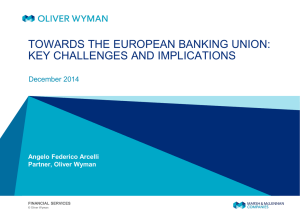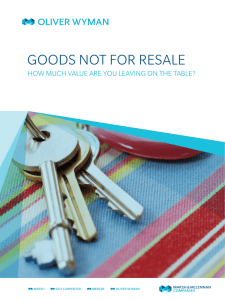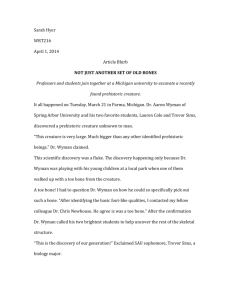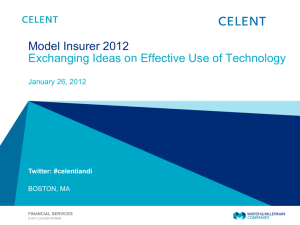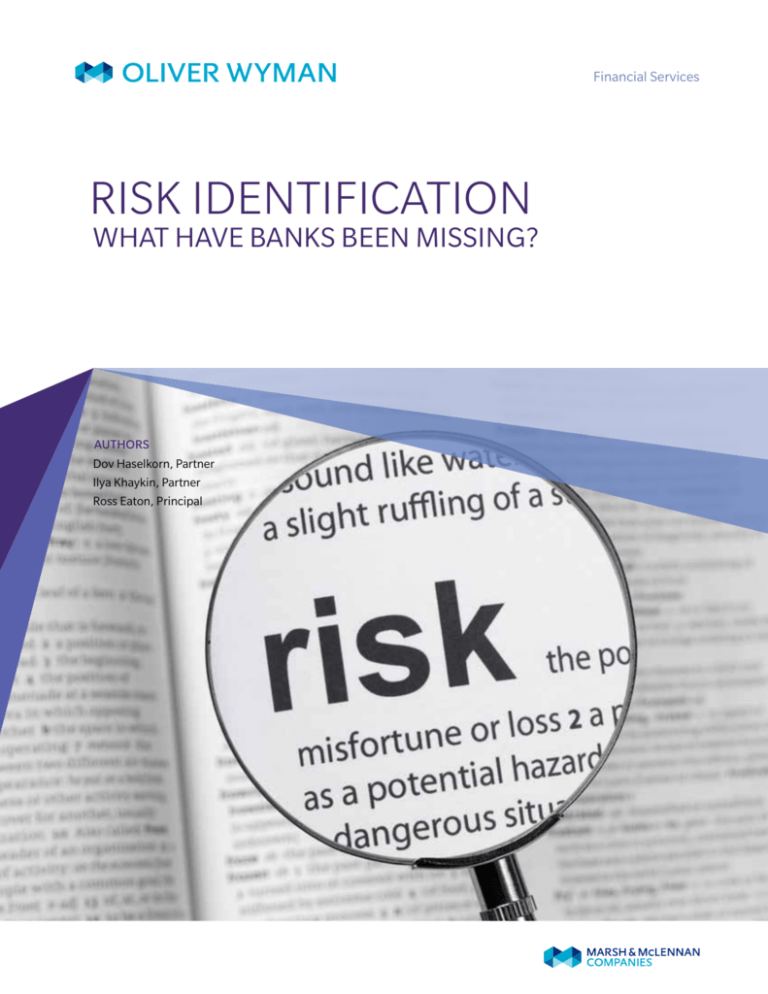
Financial Services
RISK IDENTIFICATION
WHAT HAVE BANKS BEEN MISSING?
AUTHORS
Dov Haselkorn, Partner
Ilya Khaykin, Partner
Ross Eaton, Principal
Commodities
Litigation
Information Security
Terrorist attack
Company downgrade
Regulatory
Internal fraud
Russian Conflict
Banking Crisis
Equities
crash
Run on the bank
Geographical concentration
Compliance
House price collapse
Strategic
FX
Commercial Real Estate concentration
Grexit
Earthquake
Oil & Gas Credit Concentration
Competition
China slowdown
Cyber Attack
Islamic State
Rogue trader
External fraud
Interest
Rates
Loss of key personnel
Sovereign default
Student loans
Copyright © 2015 Oliver Wyman
Reputational
Single name concentration
System failure
INTRODUCTION
Risk identification is the process of taking stock of an organization’s risks and vulnerabilities and
raising awareness of these risks in the organization. It is the starting point for understanding
and managing risks – activities central to effective management of financial institutions.
However, many legacy risk identification processes have not fully served institutions’ risk
management needs, particularly those related to firm-specific stress testing and identification
of the firm’s largest vulnerabilities. These processes were not sufficiently comprehensive and
deep enough – failing to highlight key underlying drivers of risks. This, in turn, led to critical
gaps in risk management. US regulators have taken note and have been pushing institutions
to expand and enhance their risk identification processes, and clearly link risk identification to
stress testing and broader risk management activities.
Risk identification
processes have
not fully served
institutions’ risk
management
needs, particularly
those related
to firm-specific
stress testing
Risk identification processes have traditionally centered on the key risk types of credit, market,
operational and liquidity risk. Within each, risk subtypes are defined and categorized, often
through a process that stays within the risk management organization. This approach to risk
identification is aligned with the traditional, primary mechanisms for measuring risk and capital
adequacy; both Risk-Weighted Asset (RWA) and economic capital approaches categorize risks
similarly and implement specific analytical approaches to each risk type.
However, a new risk and capital management paradigm has emerged. This paradigm is
based on enterprise-wide stress testing rather than relying primarily on traditional RWA and
economic capital measures, which often use opaque models that can be difficult to link to
observed real world conditions. The new paradigm instead involves defining a plausible but
severe forward-looking scenario, then conducting a comprehensive assessment of how an
institution would fare in this environment. Supervisors design mandatory stress scenarios
that test common firm-level risks as well as key systemic vulnerabilities. However, each
firm is also expected to develop a comprehensive stress scenario that is explicitly designed
to target its own vulnerabilities. Pushed to develop meaningful scenarios, CCAR institutions
have started to assess their vulnerabilities much more seriously. These new requirements
have now arrived for Foreign Banking Organizations (FBOs) in the US and certain non-bank
Systemically Important Financial Institutions (SIFIs) that will become subject to similar stress
testing requirements soon.
Risk identification approaches are being pushed to adapt to these new requirements as well
as address historical weaknesses observed at financial institutions. Institutions often did not
effectively identify and assess a number of the risks that emerged before, during and since the
crisis, for example:
•• Strategic defaults on mortgages
•• Mortgage repurchase risk
•• Loss of market liquidity for many traded credit products
•• Liquidity risk from rapid loss of secured funding and collateral calls
•• Litigation arising from alleged fraud and misrepresentation of structured products
3
•• Ratings downgrade-related risks
•• Wide-scale outrage and reputational effects from the crisis
Traditional risk identification processes do not incorporate enough different perspectives
on risks from across the organization; effectively distinguish the most significant risks from
more minor risks; or sufficiently consider the underlying drivers of risks and how they could
interact and amplify risks, or how minor risks might become severe in certain environments. As
institutions adopt stress testing-based approaches to risk and capital management and work
to develop stress scenarios specific to their own vulnerabilities, risk identification approaches
must evolve to enable institutions to better understand their vulnerabilities, and to mitigate or
capitalize against them.
THE NEED FOR RISK IDENTIFICATION
Risk identification is foundational to risk management in financial institutions. Transparency
into the nature of risks drives downstream applications including risk measurement, control,
and mitigation, as well as business planning, performance measurement and pricing. Key
downstream uses of risk identification include:
•• Stress test scenario design: risk identification should inform stress test scenarios to ensure
the organization’s key vulnerabilities are tested. For example, where a bank has a significant
concentration of credit exposure to a specific industry, it may need to include an additional
stress on factors which drive that industry’s credit losses (e.g. sharp decline in metals prices
increases default risk for mining companies) to better assess the extent of the risk.
•• Risk modeling and measurement of “hard to model” risks: granular identification of risks
helps verify whether models are able to effectively capture risks. In cases where complexity
or data limit the ability to model a risk (e.g. reputational or strategic risks), risk identification
can aid measurement through identification of a narrative of how the risks might materialize
in a plausible event with severe consequences.
•• Risk ownership and control: significant risks should be assigned owners – if they do not
exist already – responsible for measuring, reporting and controlling these risks.
•• Strategic planning: risk identification can inform the strategic planning process by
highlighting key risks to the plan and how alternative strategic actions might affect the
downside risk
Exhibit 1: Risk identification processes and downstream uses
Feedback
Top-down risk
identification
Identify organization’s
largest risks
Bottom-up risk
identification
Identify comprehensive
list of risks and drivers
at the BU level
Feedback
Source: Oliver Wyman Analysis
Copyright © 2015 Oliver Wyman
Iterate until top-down
and bottom-up risks
reconcile as appropriate
Review
and
challenge
Risk inventory
Update
risk inventory
Downstream uses
Materiality
assessment
Determine which
risks are material
and warrant
further attention
Risk
assessment
Complete risk
assessments;
review and
challenge
Stress testing and
capital planning
• Macro-economic
scenario design
• Risk modelling
• Measurement of
“hard to model” risks
Other uses
• Risk ownership
and control
• Strategic planning
KEY REQUIREMENTS OF RISK IDENTIFICATION TODAY
These more advanced applications of risk identification have significantly upped the demands
on risk identification processes. There are two categories of requirements: analytical
characteristics and operational characteristics.
Exhibit 2: Key requirements for a robust risk identification process
ANALYTICAL CHARACTERISTICS
OPERATIONAL CHARACTERISTICS
Comprehensiveness
• Established and emerging risks
• On and off balance sheet
• Measurable and “hard to model”
Engagement of senior management and businesses
• Improves “top-down” risk identification
• Sets the tone for rest of organization
• Ensures better linking of risks to business activities
• Enables more timely identification of emerging risks
Granularity
• Causal events/drivers as well as risk types
• Includes relationship between risks and
business activities
Materiality assessment framework
• Consistent framework across all risk types
• Typically based on likelihood and severity of occurrence
Documentation
• Consistent risk assessment template to document risks,
their drivers and materiality
• Centralization of disparate information on different
risk types
Frequency
• Annual review to ensure outputs remain current
• Updates as necessary to reflect changes in business
Source: Oliver Wyman Analysis
First and foremost, an institution’s risk identification process must be comprehensive in its
coverage of risks, including across small but quickly-emerging risks as well as risks with
weaker risk measurement. Risk identification must also extend beyond the traditional
categories of credit, market, operational and liquidity risks. Stress testing demands an
understanding of not only loss drivers but also revenue and expense drivers, such as loan
origination volumes, trading volumes, new debt/equity issuance by the bank’s clients, etc.
Broad capture of risks helps to ensure the institution has sufficient capital and liquidity, can
appropriately tailor scenarios to its own risk profile, and can manage its risk appropriately.
These broad, detailed risks should then be aggregated along a pre-defined hierarchy in
order to bring them to a level which can be broadly understood and meaningfully discussed.
The output of new risk identification processes must also be much more thoughtful, and is
qualitatively different from what is typically in place today. In addition to describing categories
of risks, it must describe their specific fundamental drivers and the underlying conditions
that give rise to losses resulting from these risks. For example, a specific systemic event such
as the circa-2011 Euro area sovereign debt crisis saw not just widened spreads for affected
governments and a widespread economic slowdown, but also increased pressures in
interbank and wholesale funding markets. Some US-based banks simultaneously faced
declining revenue in European businesses, worsening credit risk from exposures to Euro
area borrowers, and increased funding costs. Risk drivers may also be linked to multiple
types of exposure across risk categories. For example rising interest rates can drive
mark-to-market losses for AFS and HTM portfolios, and greater credit losses on variable rate
loans. This driver-based view is much more readily linkable to scenario development, making
connections across portfolios much more explicit, increasing transparency and providing
linkages within the organization with respect to the risks themselves.
5
Risk identification
cannot be
limited to the risk
function; the entire
organization must
be involved
Thirdly, those involved in risk identification and assessment will need a way to communicate
(and debate) the significance of the identified risks. Evaluating the relative importance of
identified risks and their likelihood of coinciding is critical, in order to focus management
attention and resources on the vulnerabilities (or collections of risks) that could most
meaningfully threaten the institution. Borrowed from advanced operational risk approaches,
some firms have adopted a simple “likelihood versus severity” matrix (see illustration) for
this purpose. This framework may apply to granular articulations of the risks within individual
business areas as well as more aggregated articulations at the enterprise level. Frameworks
such as this allow the organization to maintain a comprehensive list of risk drivers while also
helping users focus on those risks relevant for their specific applications.
Exhibit 3: Illustration of risk likelihood vs. impact matrix
Monthly or
more freqently
4
Model risk: prediction error
6
Interest rate risk
Annually to
monthly
LIKELIHOOD
HIGHEST RISK
1
Stolen credit card fraud
1 in 5 years
to annually
3
Litigation/Legal risk
1 in 25 years
to 1 in 5 years
Less than 1
in 25 years
8
Credit concentration – Oil & Gas
7
Compliance risk – AML
Counterparty default
5
LOWEST RISK
Minimal
9 Credit risk – retail mortgages
Minor
Moderate
Major
2
California earthquake
Liquidity risk – bank run 10
Severe
IMPACT
Source: Oliver Wyman Analysis
In terms of operational requirements, the first is greater engagement by senior management,
business units, and Finance. Senior management has the most holistic view of the institution’s
risks and risk drivers, enabling them to identify common drivers across risk types, and to
know which risks are the most significant. Engagement from senior management is also
critical to ensuring that the exercise receives sufficient attention and is more than a regulatory
compliance exercise. Meanwhile, risk identification cannot be limited to the risk function. The
entire organization must be involved in order to ensure comprehensiveness, including not just
balance sheet risks but also risks to future revenue streams. Such broad involvement of the
organization will improve understanding of the true sources of risk, clarify how risks relate to
specific business activities, and provide the best chances of identifying newly emerging risks.
Documentation and transparency are also critical not just for compliance reasons, but also
to ensure the full value is extracted from the process. It is not sufficient if a narrow group of
key individuals has a deep understanding of the organization’s significant risks but others
lack that transparency. In part, risk identification is a process that collects information that is
already known by individuals across the organization and packages the often disparate pieces
of information in a way that creates transparency around the risks, their key drivers and their
approximate magnitude. Detailed documentation of the risks in a consistent risk assessment
template (see Exhibit 4) helps to ensure this information can be used for a range of applications
by users who otherwise would not have the same comprehensive understanding of the risks.
Copyright © 2015 Oliver Wyman
While risk identification happens organically and continuously throughout the organization, a
periodic, formal process is needed to ensure that the full list of risks the institution faces, and the
assessment of their magnitude, are up-to-date. The frequency of this formal risk identification
process must consider the rate at which risks evolve and the frequency of downstream
processes that make use of the information. For many institutions, the full formal process should
be conducted no less frequently than annually, but should be updated in the interim as the
institution’s risk profile changes due to external shocks, potential emerging risks, acquisitions
or other factors.
Exhibit 4: Illustration of standardized risk assessment template
A. RISK DEFINITION
Level 1 risk
Level 2 risk
Definition
Credit
Credit concentration – Oil & Gas
Risk that a large number of Oil & Gas exposures default due to
a downturn in the sector
B. UNDERLYING DRIVERS
•• Direct driver: oil & gas prices
•• Indirect drivers: OPEC actions, Middle East conflict, anti-fracking legislation
C. QUANTITATIVE METRICS
Metric
This quarter
Last quarter
Management limit
Board risk
appetite limit
Exposure as %
of wholesale
credit exposure
4.8%
5.1%
5%
6%
D. QUALITATIVE INFORMATION
•• Concentration in sector has decreased due to tighter underwriting criteria and pricing strategy
•• Oil prices have now stabilized, though a recovery in prices is not predicted
•• Management will continue to reduce concentration in the sector to mitigate risk of further price shocks
E. SIGNIFICANCE ASSESSMENT
This quarter
Qualitative assessment
Residual likelihood
Annually to 1 in 5 years
Residual impact
Severe
Risk could cause significant loss in shareholder
value and result in earnings announcement
Overall significance assessment:
High
F. EMERGING RISK IDENTIFICATION
•• Risk is a well-known risk for the bank
•• Magnitude is not increasing rapidly
•• Therefore, this is not an emerging risk
Source: Oliver Wyman Analysis
7
COMMON CHALLENGES AND PITFALLS
It is far better to
have an imprecise
assessment of
the size of a risk
than to omit a risk
due to difficulty
in quantification
Copyright © 2015 Oliver Wyman
As institutions upgrade their risk identification processes, there are a number of key challenges
observed and anticipated:
•• Achieving organizational engagement: a robust risk identification process requires broad
participation from across the organization. Key stakeholders may be hesitant to participate
or honestly identify and assess risks – particularly if they perceive it to be a pure compliance
exercise. As indicated above, involving senior management and business units in reviewing,
challenging and complementing the risk identification results helps drive personnel to fully
engage in the process and ensures that risks are better linked to business activities.
•• Developing a robust assessment framework: while a single metric for assessing the
significance of risks is highly desirable, it is practically difficult. Under the likelihood
and severity approach described above, severity can be defined in multiple ways. Some
risks – e.g. certain strategic and reputational risks – may be impactful from a long-term
economic value perspective but not from a near-term accounting perspective. For other
risk types, quantifying the severity may be extremely difficult. Qualitative significance
assessment criteria are therefore needed to complement quantitative thresholds to ensure
such risks are not missed. It is far better to have an imprecise assessment of the size of a risk
than to omit a risk due to difficulty in quantification.
•• Ensuring consistency: the risk identification process is necessarily very distributed,
touching virtually all areas of the institution. Consistency in how risks are defined and
assessed is therefore a challenge. An appropriately senior and well-resourced central team
should therefore oversee the process and work with key stakeholders to ensure consistency
across the organization. Tools such as common risk assessment templates, guidelines for
risk identification and assessment, clear and consistent likelihood and impact definitions
are also needed to provide additional guidance and to ensure required information is
consistently collected.
•• Ensuring comprehensiveness: ensuring all risks are identified is the core challenge for
risk identification. This includes risks outside of the traditional risk types owned by risk
departments (e.g. credit, market, operational and liquidity risks) to incorporate revenue,
expense and other components impacting financial statements. The design of the
process and selection of the participants in the process should take this into account. For
example, the use of parallel top-down and bottom-up processes (as depicted in Exhibit 2)
provides a higher likelihood of identifying all of the organization’s key risks than either
process in isolation. A top-down process is led by senior management and should focus
on the organization’s most important risks, while a bottom-up process is conducted by
management across the entire organization, harnessing information already gathered
through processes such as the Risk and Control Self-Assessment (RCSA). Comparison of
the output of these processes, as well as external views on key and emerging risks, in formal
risk identification workshops, is most likely to identify the full suite of the organization’s
vulnerabilities. Owners of the risk identification process should recognize that the process
must encompass the broader organization to achieve comprehensiveness.
•• Considering both position-driven and business activity-driven risks: institutions often
focus on today’s exposures as sources of potential loss and risk. This is only part of the set
of vulnerabilities. Strategic, business and operating activities also result in structural risks
that may be unrelated to today’s positions. For example, long-term economic stagnation
may lead to low investment and low trading volumes, hurting earnings in sales and trading
activities. Other examples of such activity-driven structural risks include reputational events
leading to employee or client attrition.
•• Aligning risk identification with Intermediate Holding Company (IHC) scope: for FBOs
in the US, a challenge will be developing a process aligned with the scope of the IHC.
This new legal entity structure in most cases does not align with existing management
and reporting hierarchies, around which legacy risk assessment approaches have been
structured. Furthermore, institutions will need to identify and consider risks arising from
their position in a broader international organization – such as risks related to revenue
transfer agreements among legal entities.
9
CONCLUSION
The new paradigm of risk and capital management demands more from the risk identification
process. Much of risk management is focused on complex and sophisticated modeling,
but ultimately, if the right set of risks is not being considered, and the underlying drivers of
these risks are not well understood, the conclusions and action plans drawn will be limited
in value. Improved comprehensiveness, wider organizational engagement and increased
focus on thoughtful, forward-looking assessment of underlying risk drivers are key elements
to upgrading risk identification capabilities and good risk management. Risk managers must
design processes tailored for their organization to achieve these requirements. This will be
especially important for FBOs as well as institutions with complex or non-traditional profiles
entering the US CCAR process for the first time. Many existing CCAR banks also need to
upgrade their risk identification processes, while even those who have already invested in
upgrading their process need to frequently repeat the process and update their view of risks
as the institution’s risk profile and market conditions evolve. Only then can risk identification
effectively serve scenario design, risk measurement, and broader risk management needs to
help financial institutions weather the next storm.
Copyright © 2015 Oliver Wyman
11
Oliver Wyman is a global leader in management consulting that combines deep industry knowledge with specialized expertise in
strategy, operations, risk management, and organization transformation.
For more information please contact the marketing department by email at info-FS@oliverwyman.com or by phone at
one of the following locations:
AMERICAS
+1 212 541 8100
EMEA
+44 20 7333 8333
ASIA PACIFIC
+65 6510 9700
ABOUT THE AUTHORS
DOV HASELKORN
Partner in the Americas Finance & Risk and
Strategic IT & Operations Practices
dov.haselkorn@oliverwyman.com
ILYA KHAYKIN
Partner in the Americas Finance & Risk Practice
ilya.khaykin@oliverwyman.com
ROSS EATON
Principal in the Americas Finance & Risk Practice
ross.eaton@oliverwyman.com
www.oliverwyman.com
Copyright © 2015 Oliver Wyman
All rights reserved. This report may not be reproduced or redistributed, in whole or in part, without the written permission of Oliver Wyman and
Oliver Wyman accepts no liability whatsoever for the actions of third parties in this respect.
The information and opinions in this report were prepared by Oliver Wyman. This report is not investment advice and should not be relied on for such
advice or as a substitute for consultation with professional accountants, tax, legal or financial advisors. Oliver Wyman has made every effort to use
reliable, up-to-date and comprehensive information and analysis, but all information is provided without warranty of any kind, express or implied.
Oliver Wyman disclaims any responsibility to update the information or conclusions in this report. Oliver Wyman accepts no liability for any loss
arising from any action taken or refrained from as a result of information contained in this report or any reports or sources of information referred
to herein, or for any consequential, special or similar damages even if advised of the possibility of such damages. The report is not an offer to buy
or sell securities or a solicitation of an offer to buy or sell securities. This report may not be sold without the written consent of Oliver Wyman.


